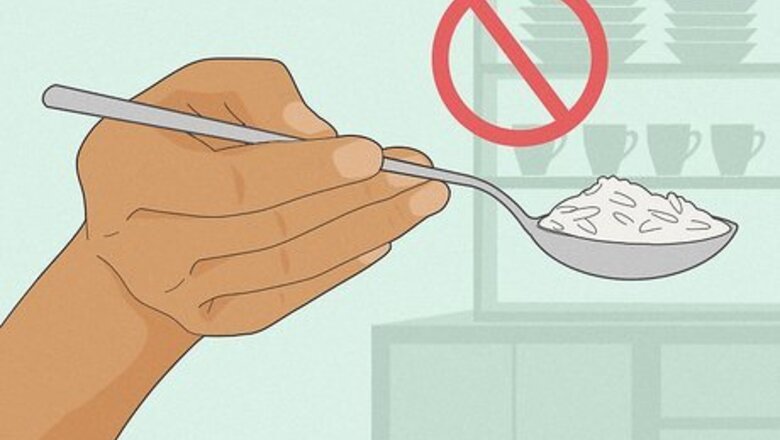
views
Eating with Your Hand
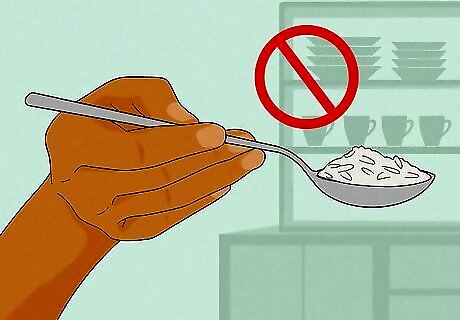
Forego utensils. Use your hand to eat most dishes. Enhance your dining experience with all five senses, including touch. Enjoy the added benefit of never burning your mouth or tongue, since any food that is too hot to touch will have to cool off before it reaches your mouth. Serving utensils are often used to collect food from a communal platter. Using a spoon to eat wetter dishes (like soups or daals) is another exception. If you find that using your hand alone is way too difficult to eat most dishes without making a huge mess, asking for a spoon is perfectly fine for newcomers. Forks and knives, however, may puncture the leaf.
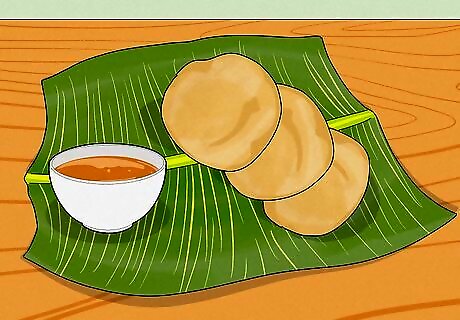
Use bread instead. Be sure to order some form of bread with your meal. Use your fingertips to transfer other food, such as curries, to your bread. Be sure to use your fingertips only, though, since many cultures regard overly messy fingers as a sign of a rude guest. Once you bite into a piece of bread, refrain from dipping it in any shared dish. Types of bread often served with banana leaf meals include chapati, khakhra, naan, paranthas, phulka, puri, roti, and rumali.
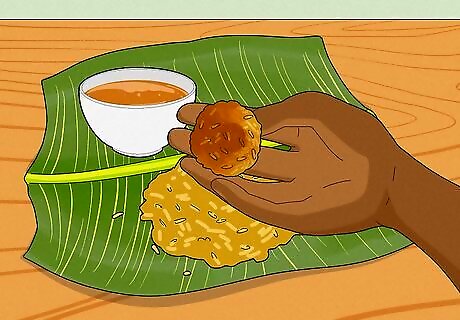
Soak up sauce with rice. Virtually all banana leaf meals come with some form of rice, so use your fingertips to collect enough to roll into a ball. Keep your index and middle fingers pressed together, and then use your thumb to roll the rice around against them until it forms a ball. Dip the ball into a sauce, combine it with a piece of vegetable, meat, or both, and then place them in your mouth. Be careful to only use your fingers to roll the rice, since using your palm can be considered rude. When bringing the food to your mouth, hold it up to your lips and nudge it inside with your thumb without inserting your fingers.
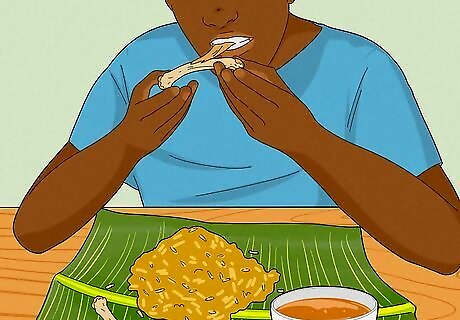
Be conscious of waste. Be aware that many societies that serve banana leaf meals frown upon wasting food. If you are eating from a communal platter, finish what you have before going back for more. When eating meat from a bone, use your fingers to pick each piece of meat off it. Clean the bone thoroughly before helping yourself to another piece. Take your time as you eat. Pay attention to your stomach to gauge how full you are becoming. Avoid treating yourself to one more helping to only then realize that you are too stuffed to eat it.
Observing Etiquette
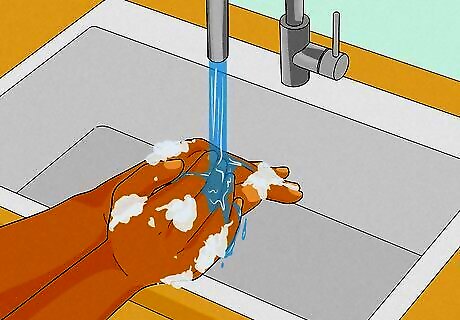
Wash your hands before and after. Since banana leaf meals are typically eaten without utensils, ensure your hands are clean before eating. Especially take care to do this if you are taking part in a communal meal where everyone shares food from a single leaf. Double-check your fingernails to make sure that all dirt and grime has been removed. Some restaurants will offer extra sinks just for this purpose. If no water or soap is available, wiping your hands clean with a cloth or towel is acceptable. Since your hands will undoubtedly get messy, be sure to wash them after eating as well.
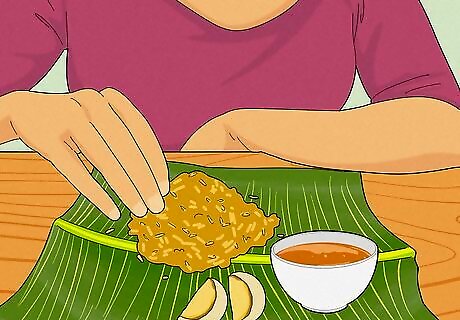
Use your right hand only. Remember that many societies that use banana leaves also happen to believe that the left hand is “unclean,” even if you thoroughly washed it before sitting down. Respect their traditions and keep your left hand below the table. Only use your right hand to handle food and other items. This rule exists because such societies are supposed to use their left hand only for cleaning their body. So placing this hand on the table where others are eating or handling shared food with it is considered disrespectful.
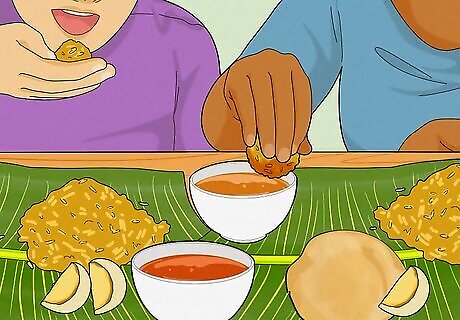
Respect your neighbors. When sharing a communal meal, be conscious of the fact that the person next to you will be helping themselves to the same dish as you. Avoid double-dipping bread, rice, or other items in shared food. When bringing food to your mouth, be careful to only place the food inside, not your fingers. Additionally: Do not help yourself to the last serving of a communal dish. Wait until your fellow diners make it clear that they do not want it. If you use a toothpick afterward, shield your mouth with your hand to catch any bits that may escape your mouth. If smoking is permitted, wait until everyone has finished eating so you do not ruin their experience.
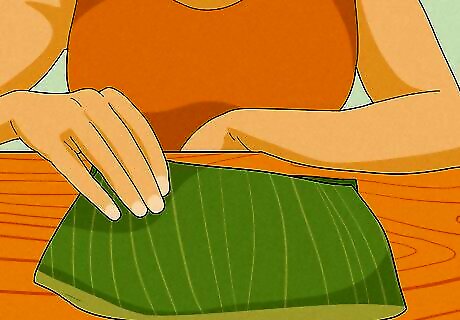
Fold the leaf afterward. Indicate to waitstaff that you have finished eating by folding your leaf in half. Fold it along its spine, with the spine facing away from you. Be aware that folding it the other way around (with the spine closest to you) is a special custom in some societies, reserved exclusively for funerals, in order to show sympathy toward the surviving family.
Serving Food

Inspect and rinse the leaf. First, make sure that the leaf is intact without any tears or other punctures. Then use cold water to wash away any dirt, dust, or other materials that may have collected on the leaf. If the leaf appears to be perfectly clean before rinsing, sprinkle water over it anyway. Pay respect toward guests by observing this custom of purification.
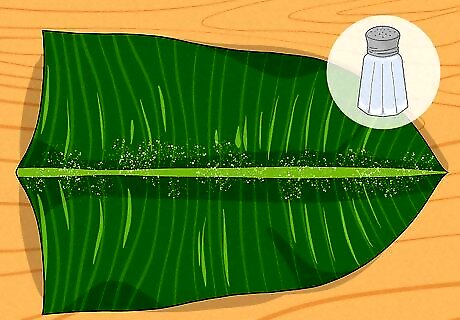
Start with salt. First, think of the leaf as a clock. Consider the top of the leaf (the narrowest end of its spine) as twelve o'clock. There, pour enough salt over the spine to serve all guests.
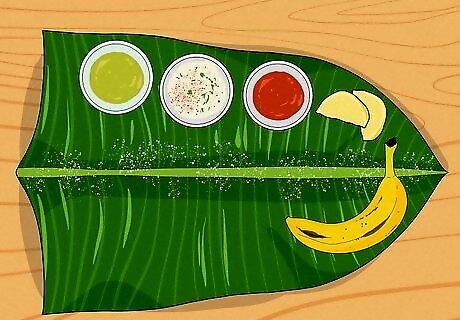
Add side dishes. Work counterclockwise. Use the left side of your leaf (from twelve to six o'clock) to arrange your sides. Starting from twelve o'clock, place your sides in ascending order of sustenance toward six o'clock. For example, the following items are placed in this order from top to bottom: lemon, chutney, raita, fritters/bhajii/nastha, and then sweets.
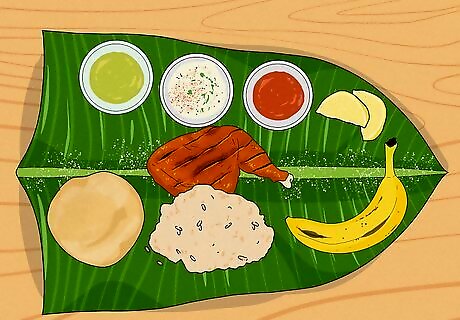
Add main dishes. Work your way back up from six o'clock. Arrange your mains along the remaining space on the leaf's right side. Start with your bread at the bottom, followed by rice, stir fries (if serving), and then your gravy or curry toward the top at one o'clock.
















Comments
0 comment